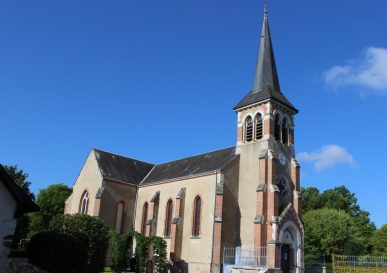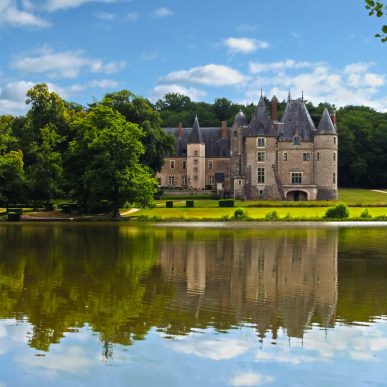In the 13 villages of the Sauldre and Sologne area, there are 14 religious buildings. Most of them were built during the XIIIth century; 3 of them were named after St Martin, widely spread in Berry, and 2 others after St Etienne (Stephen) such as the Bourges cathedral.
Each of them has its own story.
St André (Andrew) church, Argent-sur-Sauldre
When this church was built in the XIIIth century on the castle grounds, it was considered as its chapel. It still has remains of XIIIth, XVth, and XIXth centuries. The nave dates from the XIIIth century, the oratories ,the apse, the choir and the bell tower from the XVth century. After years of dammages, the building was restaored in the XIXth century. This place is also used for cultural events such as « musical September ». In 1944, it was listed in the French Heritage as a « historical monument »
The church is also used for cultural events such as the annual festival « Musical September ».
St Martin church, Aubigny-sur-Nère
This church whose protector is St Martin, bishop of Tours, IVth century (more than 4000 churches are dedicated to him), goes back to the IXth century. The southern side door dates from the XIIth century, but the aisle and the nave date from the XIIIth century. During the 100 years war, it was set on fire twice by the English (1356 & 1412). Afterwards it was restored and extended by the Stuarts of Aubigny during the XVth and the XVIth century. A little before 1500, the square porch tower was placed next to the nave. The oratories and the choir were ordered by Robert Stuart after the 1512 fire. His coat of arms is represented on a key stone which might go back to 1517 or 1527.
In the XVIIth century, a priest had forbidden pets inside the church, so the stone-cutter decided to sculpt his own dog on one of the walls in order to overcome this prohibition, thus you can always see a pet in the church.
You will notice a splendid glass roof dating back from the begining of the XVIIth century made of several stained glass windows which tell the main parts of St Martin’s life. The nave is particular because of its six parts rectangular ribbed vault. Another standing point lies in the XVIIth century way-in through the bell tower which was built as a bridge over the roadway. It was erected in the place of a previous spire, struck by lightning in 1636. In spite of its many alterings, it is an example of a particular architecture style called « transition gothic » and listed as a Historical Monument since 1862.
St Etienne (Stephen) church, Blancafort
The oldest remains of this church might date from XIIth century. It was then composed of a rectangular nave whose groundwork still exists. A bell-tower porch and a chevet have been added to it later on. A beautiful priory stands by its side. It has been listed as a Historical Monument since 1926.
St Barthélémy (Bartholomew) church and its porch-roof, Brinon-Sur-Sauldre
Built at the begining of the XIIth century, this Sologne church is unique in the Cher department for it has a porch-roof as an outdoor extension called « caquetoir ». In the old days, it was used as a gathering place to shelter parish meetings attended by the bailiff after the weekly mass. It was listed as Historical Monument in 1926.
But the tiles of the porch-roof nowadays still echo the gossips of the women who were not admitted in the local « café » (pub) with the men.
St Etienne church, Clémont
This XVth century roman church is situated in the middle of a typical Sologne village. It was restored at the end of the XIXth century and listed Historical Monument in 1928.
St Martin church, Ennordres
It is a XIIth century church from when still remain the choir, the transept and a side chapel which was turned into a sacristy. Except for the nave, the rest of this church was listed as a Historical Monument in 1921. Its bell-tower is a XIVth century square tower which seems to have been covered with a spire until the XVIIIth century but happened to be struck by lightening. The church was restored in the end of the XIXth century.
St Aignan church, Ivoy-le-Pré
Built in the XIIIth century thanks to Simon de Sully, lord of Ivoy-le-Pré and Bishop of Bourges. St Aignan (IVth century) its protector, was popular for he bravely defended the Gauls in front of Attila’s invadors. The entrance door decorations were inspired by Bourges cathedral. During the XVIth century, local lords added ribbed vaulted oratories with richly historical stained windows. A modern fresco is also visible inside the baptismal chapel. Listed as a Historical monument since 1927.
In the XVIIth century, the church vault once collapsed, but this never prevented the parishoners from meeting there, even under the rain.
St Jacques church, La Chapelle-d’Angillon
In the XVIIth century, the Duke of sully ordered it to be built on the spot of a previous one situated at the foot of the castle. It is singular for it hasn’t got a proper bell-tower, but a single tower which is not higher than the top of the nave of the actual church which was built opposite the castle.
St Martin church, Ménétréol-sur-Sauldre
As for Aubigny-sur-Nère, its patron is St Martin. It was built in the XIIIth century, and the only actual remains are the aisle and the goundwork of the local lord chapel which used to belong to the La Faye family. The nave and the vault date back from the XVth century and the bell tower from the XIXth century.
St Firmin church, Méry-es-bois
Its oldest remains might date from the XIth century but the apse only from the XVth century. Inside one can see some tombstones as well as reliquary bust of St Firmin, its protector.
St Martial church, Oizon
St Martial was the Auvergne and Limousin patron. This church dates back from the XIIth century : the choir was rebuilt in the XIVth century. The transept consists in the northern and the southern oratories and was added to the rest in the XVIth century.
St Caprais church, Presly
A first building was erected at the end of the XIIIth century, and dedicated to St Caprais. The whole building is made of bricks, the traditional materials in Sologne where limestone is very rare, which makes this church outstanding.
St Montaine church, Sainte-Montaine
This church was named after St Montaine, a local abess who cured all types of diseases. There is a legend about a mirraculous spring just outside the village which is known to help unhappy couples who can’t concieve to become parents. This church is not open to the public.
















